-
Posts
521 -
Joined
-
Last visited
Content Type
Profiles
Forums
Articles
Gallery
Downloads
Events
Posts posted by Jobtiel1
-
-
Is it possible this change in color happened during tempering?
~Jobtiel
-
Hi Steve, I changed the picture, it should be good now.
~Jobtiel
-
Looking at the grain I think your normalizing temps may have been a bit high, but more experienced metallurgists may chime in on that one. Concerning the crack, if you didn't forge it too cold it makes me believe it is due to high temp during quenching. Have you used a magnet to better estimate the quenching temp? with files I don't really need to go higher than red to get the steel non-magnetic and harden properly.
~Jobtiel
-
Hi all,
I like making axes, and I want to practice forge welding further, so I'm looking at making a socket axe most produced in scandinavia.
something akin to this:
.jpeg.db2facfb396d5a74606c72a7d59f461f.jpeg)
Do you have any idea on what the starting thickness of the material would be best suited for something like this, I have some 8 mm (.3 inches) flat bar which is wide enough to get the starting pattern out, but I'm not sure if the thickness is sufficient. Do any of you have experience with these kinds of axes?
Thanks.
~Jobtiel
-
Indeed we need some more information to define the problem you have. The alloy, where you got it from (scrapped/new), and quench medium would go a long way. What you're asking right now is like asking: "my car broke down, what part do I need" without any additional information.
~ Jobtiel
-
My stump is a piece of wood that was sitting in the backyard as a chopping block for atleast 10 years. Hard, twisted stuff, looks like it might've been chestnut.
It holding up fine, i put some pieces of pine underneath to make it a bit taller as the anvil was too low.
~Jobtiel
-
Yeah this is in my opinion easier to make than fully forging tongs from say 16mm round (minimum). Just because you save a lot of time by not having to draw out the reins. I make all my tongs this way. At least until u can get that drop tong weld consistent. The downside is that the material for the jaw and transition from jaw to boss can be limited. And thus be a weak spot.
To make this optimal compared to the figure you showed is to split the reins from the flat bar instead of forging the flat bar down. Look up "split rein tongs* splitting can take a bit long time with lower heats so make sure to have a hot fire.
In my opinion the welded reins are the perfect tong construction as you can have thick stock for a nice strong jaw and boss and thin reins without the effort of forging down the thick stock.
~Jobtiel
-
Nice work Alexander!
Most HC steel I use is old files or big cold chisels. I ordered a bar of 1095 once for some axes I sold, since using known steel there is nice. I got a complete leaf spring once from the scrapyard but I don't think I'll use that up anytime soon. I use it occasionally for bearded axes.
Today some supplies to finish the San Mai knife came in the mail, a piece of brass flat bar, brass rod, and a piece of walnut for the handle. Before assembly I etched the knife and now I just need to file, sand, and finish the handle and the lower part of the brass "guard". I'm stoked to get this finished and starting the sheath as well. It kind of is a show off piece to be honest. Also to see if I could. Second knife ever.
The cracks in the WI are still there, but nothing cracked further during hardening so it'll be fine I hope.
~Jobtiel
-
That's true, very fun when biking somewhere and having strong headwind both ways!
~Jobtiel
-
Thomas, that's pretty cool actually! When we used to go to Switzerland and chips bags we brought would also inflate up to near bursting pressures.
The realization hits sometimes when I drive over the bridge to the next island/peninsula over and the tide is up, sometimes the water reaches maybe half a meter before the top of the dike while from "ground" level the dike is 6 or more meters high!
~Jobtiel
-
That's always difficult to deal with. here in the Netherlands the discussion is always about the height of the dikes, do we build them for a storm that happens once every 10.000 years, every 100.000 years? For "daily" use they are high enough, but if you have a storm like in 1953 that you are not prepared for, half the country floods.
~Jobtiel
-
I started forging with an arrangement of hard fire bricks. certainly possible, but a JABOD would be much much better than that. I think you will getter a way better forge that way.
~Jobtiel
-
For EU members I have some links here that I use.
General knife supplies, also steel:
https://www.nordisches-handwerk.de
https://www.smederijatelieralkmaar.nl/webshop/
knife steel only:
https://www.eurotechni.com/fr/
Construction steel:
Leather:
Leatherworking supplies:
general smithing supplies:
~Jobtiel
-
Les, the cracks are just on one side. But they're too deep to be able to grind it out with the profile in mind. Maybe a false edge or something now that I'm thinking about it. I'll have to see. Does anyone know how much of a problem such a crack in the WI is for a blade? The steel part is still solid and crackless.
~Jobtiel
-
Spend some time on the San Mai blade today. Unfortunately some cracks in the WI appeared when I forged out the profile. They don't seem to go to the steel and it's on the back with a pretty thick blade. I'm going to finish and HT it for practice, but I don't know if I'll doe a handle as well or start over. Pic is after a test etch to spot file marks I still need to sand out before starting with higher grits.
I do remember again why I don't make knives very often.
~Jobtiel
-
Thomas, i was trying out a San Mai knife here. I was debating on the thickness of the file before I started, now I know to get a thicker one for the next time. I'll have to see what my eventual knife thickness will be before I decide if i need to forge more or grind it all down. I am happy that the welds took really well, another step in the journey to become good at forge welding.
~Jobtiel
-
I started on a laminated knife with wrought iron and an old file today. It's still very thick, but I was worried the file was too thin to begin with. I think I'm going to grind of some of the wrought and then continue forging in the bevels and maybe make the knife a bit longer too. But the welds took beautifully so that's a big plus! There is some cracking in the tang but I'm going to weld those a bit and since it's the tang I don't think they are that significant. Forged the tang a bit too cold I think.
~Jobtiel
-
Nice score! These patterns of vises are indeed a bit rare, but post vises in general are quite common. you often find the German patterned vises (luckily I like these). I would offer 80 max as well since you can get the German vises for 30-40 euros and if you spend some time looking sometimes cheaper. Have fun with it!
~Jobtiel
-
Over here the dress code largely stays more formal though. Still needing to take out piercings and cover tattoo's if you have a job where you come in contact with customers. I have however never seen a blacksmith dressed in a business suit ;).
~Jobtiel
-
Fair enough, I do axes and adzes with forge welded bit as well. I have a small offcut of 1095 that is perfect for a nice gouge. I'll forge it next time I have some time for it.
~Jobtiel
-
Anvil, this is really good information, thank you. Unfortunately I don't have the resources to buy full bars of good tool steel. But seeing that you annealed the whole tool except the end, I think I can get away with a forge welded edge. I have some (very) flat bar 1095 or old files that I was planning to use. Should I get the slightly lower carbon content or do you think this higher carbon works fine for the stresses of lathe turning?
~Jobtiel
-
I think you should normalize it and quench at lowe temp, orange-yellow is too hot I think.
~Jobtiel
-
I got some ostrich farms nearby for the artillery...
~Jobtiel
-
I just found this thread back looking for some info on good vise stands. Fun fact, I still haven't forged a new bolt for the thing. I heard people say there is nothing more permanent than a temporary solution.
~Jobtiel


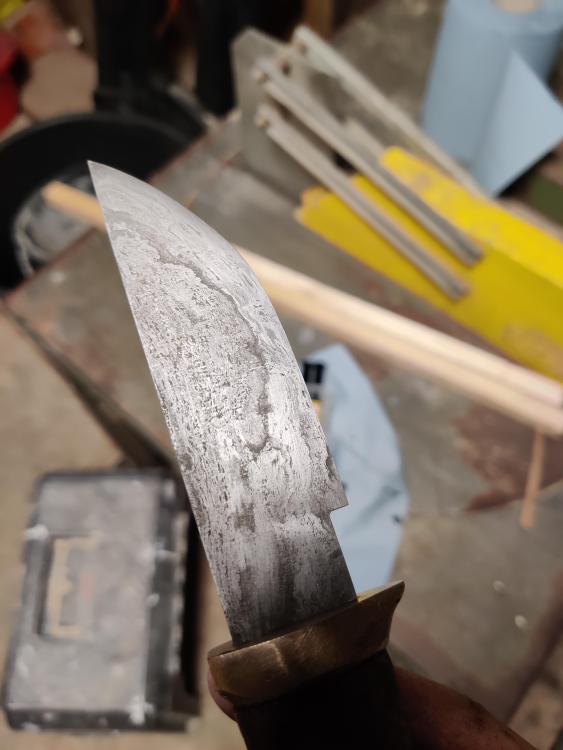
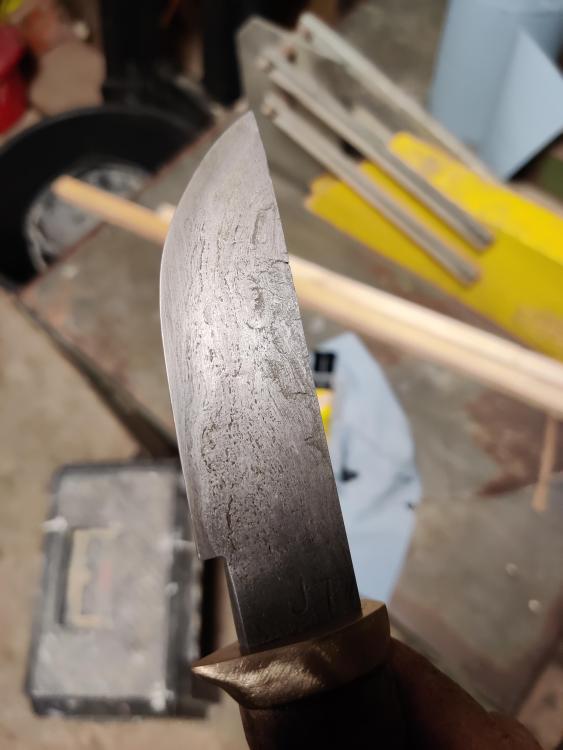
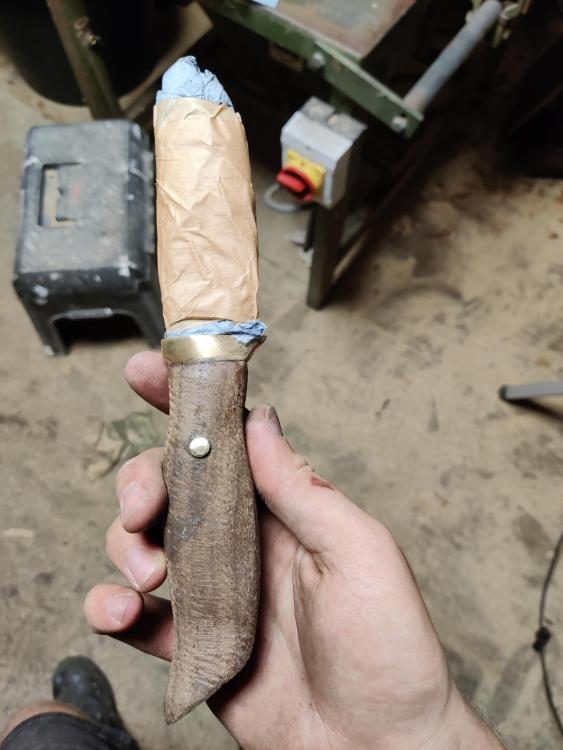
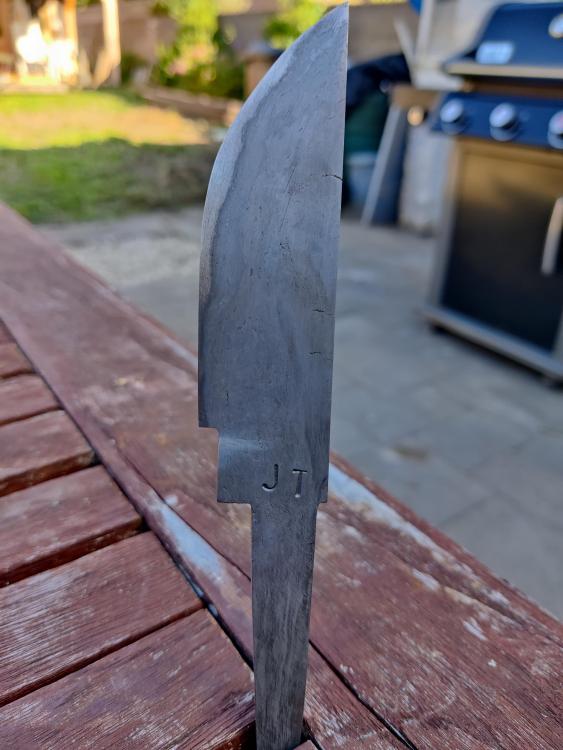
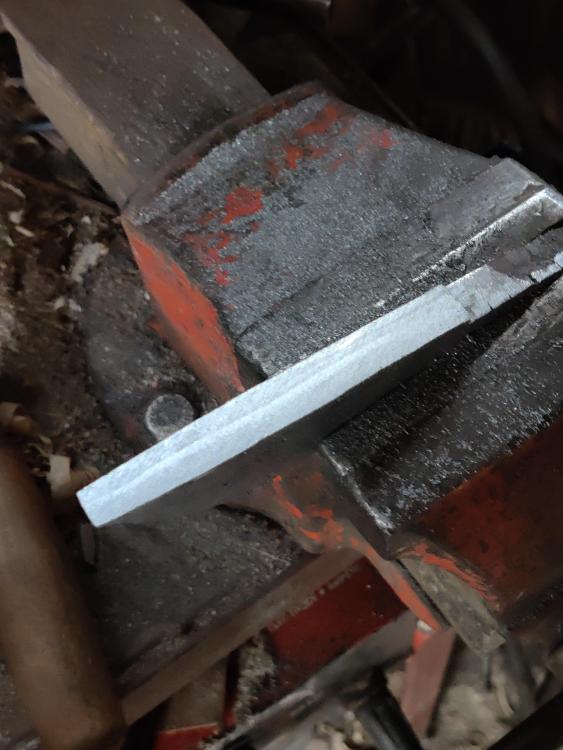
Socket axe
in Axes, Hatchets, Hawks, Choppers, etc
Posted
I have experience forging and forge welding axes, but it's not like I'm an expert. I'll have to look that up and see if there are mentions of preferred stock sizes, thanks!
I want to see if I can get the forge welds, I have been nailing them pretty consistently lately and have done quite some good welds on projects, I guess this is just to see how far along I am with forge welding as I want to get good at it. plus the axe looks really nice so I'd be happy to own one that I made.
~Jobtiel